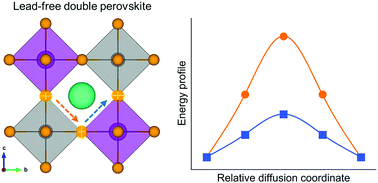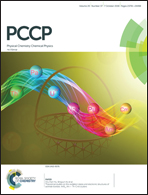First-principles study of anion diffusion in lead-free halide double perovskites
Abstract
Halide ion diffusion in organolead halide perovskites has raised great concern in recent years and been considered as the reason for the hysteresis of current–voltage curves and degradation of perovskite solar cells. In this work, X-site halide ion diffusion in lead-free double perovskites Cs2AgBiX6 (X = Cl, Br), Cs2AgSbCl6 and Cs2AgInCl6 is investigated by first-principles calculations. The formation energies of X-site vacancies are calculated for these double perovskites, and predicted to be related to the electronic configurations of B-site cations. Cs2AgInCl6 is found to have the lowest vacancy formation energy among these double perovskites due to the unfilled s-orbitals of In3+. Using the climbing-image nudged elastic band method, these double perovskites are found with different barriers for halide ion migrations around Ag- and BIII-octahedrons due to different migration bottleneck radii and B–X bond characters. In our calculations Cs2AgBiBr6 shows the lowest energy barrier for X-site ion migration, which can explain the phenomenon of the huge hysteresis in Cs2AgBiBr6 solar cells reported. These results reveal X-site vacancy formation and diffusion properties in these lead-free halide double perovskites, which could be useful theoretical support for their optoelectronic application.



 Please wait while we load your content...
Please wait while we load your content...